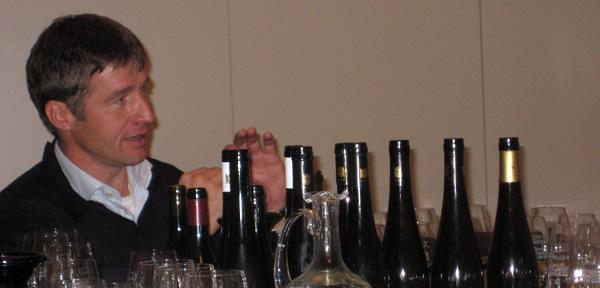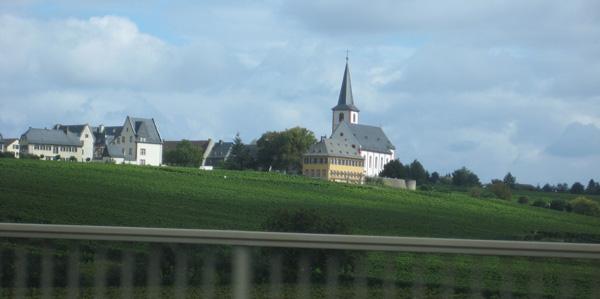The Kunstler estate has recently moved into new headquarters. Well, old new headquarters. The great building on the Geheimrat-Hummel-Platz that Kunstler now calls home formerly housed the Rheingau's oldest sparkling wine manufacturer. True story. The 1837 building is considered a landmark and has some wonderful architectural details. Though the new tasting rooms that Gunter Kunstler and family have redone are undeniably slick with some modern touches (they have automatic sliding glass doors - "komisch!"), they've done a great job of keeping the soul of the building front and center - it's truly beautiful and a wonderful place to taste wine. Believe me, 11am on a Tuesday rarely looks as good for me as a lineup of 19 different Kunstler wines, going back some 10+ years.

You have arrived. Hochheim's Geheimrat Hummel-Platz. It's fun to say!
2006 was tough for Kunstler, there's just no getting around that. If the commitment to quality here was anything less than masochistic and outrageous, they would have been in trouble. I can only assume that they have a compulsion to greatness because the 2006s are fantastic. The 2006 Hochheim Holle Erstes Gewachs (dry) is superb; dense with ripe perfumes, pineapple and saline mineral notes, a brooding age-worthy monster. Agile, even given its size and broadness. The 2006 Hochheim Kirchenstuck Erstes Gewachs (dry) is slightly more feminine than the Holle (or the Domdechaney), a more lively nose of mango, kiwi and blood orange. Absurdly glossy with suave oily edges and amazing concentration. One of the better dry 2006s I've had, period. These are not to be missed.
In the U.S. the Mosel estates get all the attention and this is a tremendous shame because there is greatness tucked here and there in Germany. Riesling buffs who've had their head in the history books will tell you, yes, the Rheingau was once considered the greatest winemaking region in Germany, but something happened in the last 100 or so years and many of the "great" estates just aren't that great anymore. A few, however, have kept the flag flying for Rheingau Riesling and Kunstler is certainly one of them. Kunstler is slowly inching itself towards the top, if they're not there already.

Gunter laying down the law at the head of the table. This guy is as cool as Kirchenstuck.
How bad was 2006? Gunter Kunstler sat quietly at the head of the large tasting table and told me in an unflinching tone that in 2006 the estate spent nearly $15,000 to cut away about one-third of the crop. Do you get annoyed paying taxes? Does it bug you that you have to pay the first month, the last month, and provide a security deposit to rent an oversized closet in Manhattan? Imagine a business model where you have to spend $15,000 to lose about one-third of your revenue. This is "quality over quantity" at its most extreme and absurd (reason #1,482 to drink German Riesling Monday through Friday).
There is a rising chorus of wine professionals who are saying that 2006, though it was rough, has produced great wines - in many instances better than 2005. Let me add my voice to this chorus: Those who skip the 2006 vintage (and yes, I know the 2007s are on the horizon) will miss some heart-breaking wines with the depth and soul that only comes about through adversity. Kunstler is the perfect example here.

The church, or "Kirche" in German, on the southern side of Hochheim. Kirchenstuck means "the piece of vineyard for the church," and indeed this famed vineyard lies back and to the south. In the foreground, this is Domdechenay.
The estate owns some of the greatest sites in the Rheingau and certainly have some land in just about every heavy-hitter in the small town of Hochheim: Kirchenstuck, Domdechenay, Holle and Stielweg. As you cross over the Rhein heading north into Hochheim, this angled blanket of vineyards comes into focus, taking advantage of the Rhein's western run and the south-facing slopes that result.
Holle and Domdechenay have the heaviest soils, and produce wines of formidable power and bluntness - for this reason, Gunter sometimes ferments and ages the wines from these two vineyards in old oak, to soften them up a bit. That said, there is no simple winemaking formula at Kunstler, both stainless steel tanks and wood are used as each vineyard, and vintage, dictates.

Six of the 19 wines of the 2+ hour session, escalating to some dense BAs and TBAs.
If the 2006 collection has a theme it's expansiveness. All of Kunstler's 2006s slide across the palate and expand horizontally, with a mouthwatering saline and citrus acidity that pushes gently on the inner cheek with a wonderful persistence. The wines are, almost across the board, phenomenal. The 2006 Estate Riesling is a treat, a big middle finger to the vintage it's so fresh and clean. The Stielweg is broad, though it has more finesse than it knows what to do with. The two Erstes Gewaches produced by the estate - the Kirchenstuck and Holle - are benchmark Rheingau Rieslings: ripe fleshy fruits, a long and wide midpalate with heft and style and plenty of acidity. (Remember how they dumped about 1/3 of their crop? Well - this means things are in short supply. Click the button below to see our real-time inventory of Kunstlers, including their Erstes Gewachs.)

Dirty old bottles in a dark cellar rule - is there anything better? Look for Kunstler re-releases. They can be outrageous!
A special mention should be made of the Kunstler cellar and the estate's propensity to re-release older vintages as they benefit from age. The 1997 Domdechenay is one of the latest of these releases and it is a beautiful example of how Rieslings deepen with age - the 1997 is spring water dusted with pears, honeyed fruits, marzipan, tea and earth and green pine needle resin notes, ripe creamy lemon citrus and a wide saline acidity. This is so freakishly good, and will be for the next year or two. Oh man... drink up!

